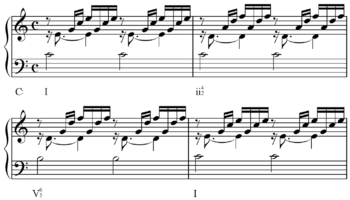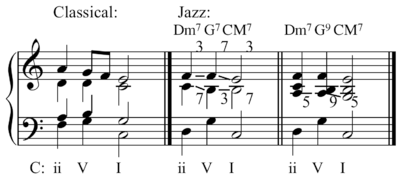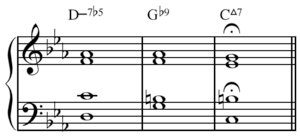ii–V–I progression



The ii–V–I progression (occasionally referred to as ii–V–I turnaround, and ii–V–I) is a common cadential chord progression used in a wide variety of music genres, including jazz harmony. It is a succession of chords whose roots descend in fifths from the second degree (supertonic) to the fifth degree (dominant), and finally to the tonic. In a major key, the supertonic triad (ii) is minor, and in a minor key it is diminished. The dominant is, in its normal form, a major triad and, commonly, a dominant seventh chord. With the addition of chord alterations, substitutions, and extensions (most often sevenths), limitless variations exist on this simple formula.
ii–V–I has been used for years and is currently "a staple of virtually every type of popular music," including jazz, R&B, pop, rock, and country.[3] Examples include "Honeysuckle Rose" (1928), which, "features several bars in which the harmony goes back and forth between the II and V chords before finally resolving on the I chord,"[3] and "Satin Doll" (1953),[4] and "If I Fell".[5]
Jazz
ii–V–I progressions are extremely common in jazz. They serve two primary functions, which are often intertwined: to temporarily imply passing tonalities, and to lead strongly toward a goal (the "I" chord). One potential situation where ii-V-I progressions can be put to use is in a blues, whose generic form has no such progressions. In this example, a simple 12-bar F blues is shown followed by a similar one with some basic ii–V–I substitutions (in bold):
| F7 | Bb7 | F7 | F7 | Bb7 | Bb7 | F7 | F7 | C7 | Bb7 | F7 | C7 || | F7 | Bb7 | F7 | Cm F7 | Bb7 | Bb7 | F7 | Am D7 | Gm | C7 | F7 | Gm C7 ||
In bar 4, instead of the simple V I root motion in the original blues, the ii chord of the B♭7 (Cm) is included so that the measure is even more directed toward the following downbeat with the B♭7. In bars 8-10, instead of leading back to the tonic with the standard V–IV–I (blues cadence), a series of applied ii–V–I progressions is used to first lead to Gm, which then itself is reinterpreted as a ii and used to lead back to F7 through its own V, which is C7. In the last bar (the "turnaround"), the same type of substitution is used as that in bar 4. In practice, musicians will often add extensions to the basic chords shown here, especially 7ths, 9ths, and 13ths, as seen in this example:
iim9 V♯9♭13 Imaj9
In jazz, the ii is typically played as a minor 7th chord, and the I is typically played as a major 7th chord (though it can also be played as a major 6th chord). The ii7–V7–Imaj7 progression provides smooth voice leading between the thirds and sevenths of these chords; the third of one chord becomes the seventh of the next chord, and the seventh of one chord moves down a half-step to become the third of the next chord. For example, in the key of C, the standard jazz ii–V–I progression is Dm7–G7–Cmaj7, and the thirds and sevenths of these chords are F–C, B–F, E–B; inverted for smoother voice leading, these become F–C, F–B, E–B.
The ii is sometimes replaced by the II7, giving it a more dissonant, bluesy feel; this is especially common in turnarounds. Additionally, the ii can be treated like a temporary minor tonic, and preceded by its own "ii-V", extending the basic progression to a iii–VI–ii–V–I; again, this is quite common in turnarounds (with the iii–VI replacing the I in the second-to-last bar; in the example above, the last two bars would change from F7 | Gm-C7 to Am-D7 | Gm-C7).
The ii-V7-I can be further modified by applying a tritone substitution to the V7 chord, replacing it with the ♭II7 chord. This is possible because the ♭II7 has the same third and seventh as the V7, but inverted; for example, the third and seventh of G7 are B and F, while the third and seventh of D♭7 are F and C♭, which is enharmonic to B. Performing this substitution (in this case, changing Dm7–G7–Cmaj7 to Dm7–D♭7–Cmaj7) creates smooth chromatic movement in the chord roots—the root of the ii (D) moves down a half-step to become the root of the ♭II7 (D♭), which moves down another half-step to become the root of the I (C).
The tritone substitution, the substitution of ♭II7 for V7, and the III–VI–II–V extension can be combined in different permutations to produce many different variations on the same basic progression—e.g. iii7–♭III7–iim7–♭II7–Imaj7–III7–♭III7–II7–♭II7–I7, etc.

The backdoor progression can be a substitution for ii–V–I using iv–♭VII–I.
The ii–V pair is also sometimes used without function (actually i–IV) in place of a minor tonic, to accommodate be-bop improvisations.[7]
Classical

ii–V–I is part of the vi–ii–V–I progression of root movement by descending fifths, which establishes tonality and also strengthens the key through the contrast of minor and major.[8]
In the tonal tradition, the ii–V–I progression is most often reserved for cadences, and is one of many often used cadential progressions. The ii, V, and I can all appear in inversion, although usually without significant alteration beyond the addition of sevenths. One very common implementation of ii–V–I in a classical piece would be this progression, where the ii chord appears in first inversion:
ii6-V7-I.
Minor key


In minor, a seventh chord built on the supertonic yields a half-diminished seventh chord, which is a very strong predominant chord. Due to what is considered the harsh nature of root position diminished chords, the iiø chord most often appears in first inversion.
The iiø chord appears in the natural minor scale and may be considered a minor seventh chord with a flatted fifth and is used in the ii–V–I in minor[10]
See also
Sources
- ↑ Kostka, Stefan, and Dorothy Payne (1995). Tonal Harmony, with an Introduction to Twentieth-Century Music, p.227, third edition. New York: McGraw-Hill. ISBN 0-07-035874-5.
- ↑ Jonas, Oswald (1982). Introduction to the Theory of Heinrich Schenker, p.26 (1934: Das Wesen des musikalischen Kunstwerks: Eine Einführung in Die Lehre Heinrich Schenkers). Trans. John Rothgeb. ISBN 0-582-28227-6.
- 1 2 Workman, Josh. "Chops: II-V-I Survival Tips", Guitar Player 37:4 (April 2003), p. 90.
- ↑ Jazz Standards Songs and Instrumentals (Satin Doll)
- ↑ Walter; The Beatles As Musicians: The Quarry Men Through Rubber Soul, p. 231.
- ↑ Humphries, Carl (2002). The Piano Handbook, p.128. ISBN 0-87930-727-7.
- ↑ Strunk, Steven, ed. (2007), "Harmony", The New Grove Dictionary of Jazz, 2nd Edition, Oxford University Press
- 1 2 William G Andrews and Molly Sclater (2000). Materials of Western Music Part 1, p.227. ISBN 1-55122-034-2.
- ↑ Boyd, Bill (1997). Jazz Chord Progressions, p.6. ISBN 0-7935-7038-7.
- 1 2 Coker, Jerry (1984). Jerry Coker's Jazz Keyboard, p.23. ISBN 0-7692-3323-6.